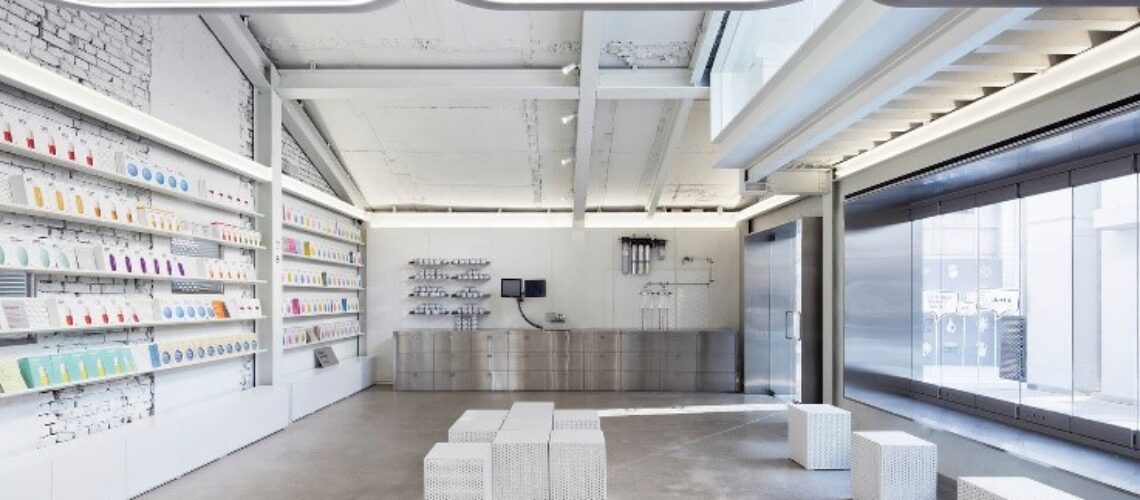If retailers are to bounce back after lockdown lifts, it will only be through establishing their premises not solely as experiential playgrounds, but also as trusted and transparent safe havens. This is important both to inspire confidence in what are likely to now be hyper-hygiene-conscious consumers, but also to ensure operations will be able to continue as close to the new normal as possible should another such event (or relapse) occur.
History has already shown us quite how drastic an effect disease can have on spatial design. Many of the tropes of modernist interior architecture were inflected with a desire to develop more hygienic spaces, spurred by outbreaks of diseases like tuberculosis. The sanatoria designed to treat them, with their emphasis on light, air, simplicity of form and material, still inform what we think of as aspirational today.
While the question of whether or not COVID-19 will play such an outsize role in future design remains, it will undoubtedly impact how we create space. This will be true across sectors, but is perhaps most influential in retail, where we’re witnessing an era of maximalist store design. That includes exploratory wind circulation routes, esoteric material palettes and an excess of surfaces, all of which send a red flag to contact-wary shoppers.

Surface treatments have come in for particular scrutiny during the pandemic. Studies have shown that the virus can live for up 72 hours on commonly used materials such as plastic and steel. Researchers such as Bill Keevil, professor of environmental healthcare at the University of Southampton, have been advocating for a return to the mass use of copper, on which the virus can last for only 4 hours. ‘We’ve seen viruses just blow apart,’. ‘They land on copper and it just degrades them.’ Manufacturers who have invested R&D spend in creating new anti-microbial surface products for healthcare providers, will likely see increased interest from businesses in other public-facing sectors. While low-touch retail will remain a priority, brands will still want to ensure their fit-out isn’t acting as a carrier. How to do this without descending into sterility, and while still asserting key narratives, will be the real design challenge.
This will matter little if retailers don’t also rationalize the way they manage space, however. Some, such as discount grocer Lidl, are using floor markings to demarcate distance, with merchandising infrastructure shifting to fit this new grid. Others, like supermarket brand Tesco, have enforced one-way systems, a particular novelty for a retail typology known for intentionally confusing shoppers’ sense of direction.
‘Despite the havoc that is being caused by the outbreak of the coronavirus, I believe that the crisis is bringing into focus a number of pre-existing problems with the way in which we shop, such as complicated and constantly changing store layouts and confusion about where products are,’ argues Will Broome, CEO of retail technologist Ubamarket.

Air quality will also be a key factor, with health professionals offering advice on the virus-mitigating benefits of simply opening windows. This will accelerate the uptake of already prominent design tactics orientated around biophilia and porous spaces as consumers come to expect access to fresh air at all times. Where appropriate, this might also take the form of advanced filtration systems, like those currently employed by brands such as Stella McCartney and Dr. Jart+, to protect shoppers against airborne pollutants. In the latter example, customers enter the skincare company’s Seoul store via an industrial air-shower booth that blows off dust and germs accumulated in the outside world.
In such instances, the expressive integration of HVAC infrastructure into public spaces will be a gesture of reassurance. Indeed, developing a new toolkit of spatial semiotics that signal when a shopper is entering a ‘controlled environment’ will be key to helping brands communicate that they’re putting customer safety first. For Betwin Space Design, the architects behind Dr. Jart+’s flagship, the primary goal was ‘to show customers that the space provides them with the cleanest air and water and protects them against pollution,’ explains co-founder Hye-jin Yang.

